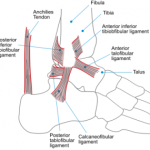Introduction
It will come as no surprise to anybody that we are in the business of treating soft tissues injuries. If this is a surprise.. stand up and walk away from the screen now … this information or website is not for you! But for the majority of physiotherapists who treat acute soft tissue sports injuries we will base our early interventions around the PRICE principle (protection, relative rest, ice, compression, elevation). This would be considered a component of gold-standard management… but why?
The Compressing Issue
About a year ago we featured an article on the protocols of RICE vs MEAT for the management of acute ligament sprains. Recently, I was contacted by Darron Goralsky regarding the clinical efficacy (or otherwise) of compression following acute injuries. Darron is the Principal Physiotherapist and Director of More Than Physio, he has completed post-graduate course in manipulative therapy, is a CranioSacral Therapist, a certified SpiderTech Kinesiology Taping Instructor and is also the co-director of education for SpiderTech.
Darron was reading the article on RICE VS MEAT and noted that the author was unable to explain why Compression may not be useful (as proposed by the MEAT crowd). He felt he may have some possible explanations worth sharing.
A Case Against Compression?
Those who utilise the kinesiology or kinesio-taping techniques are aware that dramatic results in the reduction of swelling and bruising can be achieved via taping a special way, known as the “Microcirculatory Technique”. Some proposed mechanisms of how taping works are that it:
- Lifts the skin (rather than compressing it) to create better superficial fluid dynamics (which compression counteracts)
- Creates pressure gradients between the limbs of tape (hence the striated appearance of the bruising resolution which is shown below)
- Stimulates the Merkel cells (mechanoreceptors) via the taping wrinkling the skin (accordion effect) which stimulate:
- Superficial vasodilation
- A Beta fibres (which have a gating effect of pain and spasm)
- Langerhans cells (which can improve wound healing).
A Crushing Victory Over Compression?
An interesting concept to discuss is the movement of interstitial fluid into the lymphatic vessels. In the case of swelling/oedema the expanding interstitial fluid volume exerts radial tension on the filaments attached to endothelial cells of initial lymphatics, which increases luminal volume. This results in a small pressure gradient that drives interstitial fluid into the lymphatic vessels. In addition, increased luminal diameter reduces the resistance to lymph flow (Scallen et al., 2010). Are you going cross-eyed yet? Quite simply whilst we utilise compression to reduce oedema, we may be impairing the clearance of oedema by inhibiting the normal function of our lymph vessels (see the image below).
A Few Case Examples
Here are a few of Darron’s case examples following treatment with Spidertech taping. Note the striated appearance of the bruising resolution.
Grade 2 Calf Strain
Iliac/Lumbar Bruising
It is worth noting that these visual improvements correlated with clinical improvements in function, pain, ROM.
What Are Your Thoughts?
What do you reckon? Abandoning compression as an acute treatment is going to be difficult and I for one am not going to recommend it, particularly in the presence of widespread anecdotal and research supporting evidence (Kraemer et al., 2001). However, this surely does present some thought-provoking concepts and ideas. If we are not challenging our current notions then we are not progressing (both individually and as a profession). Let Darron and I know your thoughts in the comments or catch me on Facebook or Twitter
If you require any sports physiotherapy products be sure check out PhysioSupplies (AUS) or MedEx Supply (Worldwide)
References
Kraemer WJ, Bush JA, Wickham RB, Denegar CR, Gómez AL, Gotshalk LA, Duncan ND, Volek JS, Putukian M, Sebastianelli WJ. Influence of compression therapy on symptoms following soft tissue injury from maximal eccentric exercise. J Orthop Sports Phys Ther. 2001 Jun;31(6):282-90.
Scallan J, Huxley VH, Korthuis RJ. Capillary Fluid Exchange: Regulation, Functions, and Pathology. Colloquium Series on Integrated Systems Physiology: From Molecule to Function 2010 2:1, 1-94
Related Posts
















Very interesting discussion guys. I wonder if we get compression on immediately might we limit the bleed in the first place? If not, the application of the kinesio taping techniques have sound hypotheses and anecdotes behind them – I’ve used it with good effect. Further, for areas where swelling presents a troublesome mess, like around the ankle malleoli, I still prefer to use J-pads and U-pads to physically compress tissue to limit accumulation of the post-swelling scarring that can stubbornly restrict dorsiflexion down the track. Good chat.
Thanks for the feedback! Interestingly, David O’Sullivan nearly had exactly the same thing to say over on The Sports Physiotherapist Facebook Page. Seems like a good plan, and many people seem to believe the 2 techniques are not mutually exclusive and should be utilised together! Thanks again.
Very interesting issue…
I think the reasoning for different applications changes with the environment a patient presents. I.e. whether its acutey in a team setting or in a private clinic. Also i think we need to remember the two sides to swelling. I totally agree with David, excessive swelling can be hard to manage and affects ROM. However we must remember swelling is a key component of the repair process, so swelling must not be seen as a total negative. The use of ‘horseshoes’ has a massive visual affect on swelling around the malleolus, but as the sportsphysiotherapist suggests….what effect does this have on promoting lymphatic drainage??
I obviously advocate the use of kinesio taping, however i love my cyrocuff, and use it all the time acutely with sports teams to prevent the initial haemarthrosis. Very interesting issue…